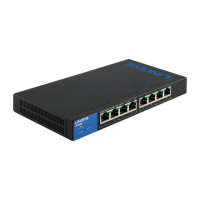92
Table of Contents
Linksys
Table of Contents
Linksys
Chapter 14 Quality of Service
The Quality of Service feature is applied throughout the network to ensure
that network traffic is prioritized according to required criteria and the desired
traffic receives preferential treatment.
This section covers the following topics:
• Feature Configuration
• Queue Scheduling
• CoS/802.1p to Queue
• DSCP to Queue
• Bandwidth Control
• Egress Shaping
• Basic QoS
• QoS Statistics
Overview
The QoS feature is used to optimize network performance.
QoS provides the following:
• Classification of incoming traffic to traffic classes, based on attributes,
including:
• Device configuration
• Ingress interface
• Packet content
• Combination of these attributes
QoS includes the following:
• Traffic Classification—Classifies each incoming packet as belonging to a
specific traffic flow, based on the packet contents and/or the port.
• Assignment to Hardware Queues—Assigns incoming packets to
forwarding queues. Packets are sent to a particular queue for handling
as a function of the traffic class to which they belong. See Queue
Scheduling.
• Other Traffic Class-Handling Attribute—Applies QoS mechanisms to
various classes, including bandwidth management.
QoS Operation
When using the QoS feature, all traffic of the same class receives the same
treatment, which consists of a single QoS action of determining the egress
queue on the egress port, based on the indicated QoS value in the incoming
frame. This is the VLAN Priority Tag (VPT) 802.1p value in Layer 2 and the
Differentiated Service Code Point (DSCP) value for IPv4 or Traffic Class (TC)
value for IPv6 in Layer 3. When operating in Basic Mode, the device trusts this
external assigned QoS value. The external assigned QoS value of a packet
determines its traffic class and QoS.
The type of header field to be trusted is entered in the Basic QoS page. For every
value of that field, an egress queue is assigned, indicating through which queue
the frame is sent, in the CoS/802.1p to Queue page or the DSCP to Queue page
(depending on whether the trust mode is CoS/802.1p or DSCP, respectively).
QoS Modes
The QoS mode that is selected applies to all interfaces in the system.
• Basic Mode—Class of Service (CoS).
All traffic of the same class receives the same treatment, which is the
single QoS action of determining the egress queue on the egress port,
based on the indicated QoS value in the incoming frame. This can be the
VLAN Priority Tag (VPT) 802.1p value in Layer 2 and the Differentiated
Service Code Point (DSCP) value for IPv4 or Traffic Class (TC) value for
IPv6 in Layer 3. When operating in Basic Mode, the device trusts this
external assigned QoS value. The external assigned QoS value of a packet
determines its traffic class and QoS.
The header field to be trusted is entered in the Basic QoS page. For every
value of that field, an egress queue is assigned where the frame is sent in
the CoS/802.1p to Queue page or the DSCP to Queue page (depending
on whether the trust mode is CoS/802.1p or DSCP, respectively).
• Disable Mode—In this mode all traffic is mapped to a single best effort
queue, so that no type of traffic is prioritized over another.

